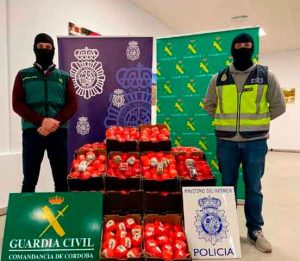According to the latest European Drug Report 2024, cannabis remains by far the most widely used illicit drug in Europe. National surveys on cannabis use indicate that, overall, it is estimated that around 8% of European adults (22.8 million people aged between 15 and 64) used cannabis last year.
However, as a counterpoint, the total amount of cannabis seized in the European Union dropped significantly, largely due to a decrease in seizures in our country, Spain.
Spain, a true European powerhouse.

This may reflect an adaptation of supply routes by those involved in cannabis and cannabis resin trafficking from North Africa to Europe, in response to anti-drug trafficking measures adopted by Spanish authorities.
In this context, it is also interesting to note that since 2019, the volume of cannabis herb seized has increased significantly in Spain.
In 2022, Spain accounted for 69% of all resin seized, 47% of all cannabis herb seized, and 81% of the total number of cannabis plants seized in the European Union, highlighting Spain’s important role both as a transit country for cannabis trafficking and as a production area.
In 2023, for example, Spanish authorities seized 22 tons of cannabis resin hidden in fake tomato packaging suspected of being destined for trafficking in France, the country with statistically the highest cannabis consumption in the euro area, and at the same time one of the European countries with the strictest laws on cannabis use and its derivatives.
Resin vs. Herb
Although new products and forms of this drug exist, cannabis herb and cannabis resin remain the most common available forms. Although the quantities of cannabis resin seized in the European Union are higher than those of cannabis herb, this is believed to reflect the greater vulnerability of cannabis resin to interdiction measures in cross-border trafficking rather than availability or consumption.
Available information suggests that cannabis herb is the most commonly available form of the drug in most countries.
Cannabis herb can be grown near its market of consumption, which may reduce the risk of detection.

The average potency of seized cannabis resin (2022 data) contains almost 25% THC. According to the EUDA (European Union Drugs Agency), this is a very high figure compared to historical levels, posing significant health risks, especially when associated with early onset use.
By contrast, the average potency of seized cannabis herb has remained around 10% THC for several years.
However, it is important to note that cannabis production and trafficking are beginning to diversify and take place in other parts of the European Union.
Cannabis trafficking in Europe diversifies
Some new cannabis seizures entering Europe may indicate that trafficking routes are diversifying and increasingly challenging interdiction efforts.
These efforts include, for example, the seizure of 4 tons of cannabis resin originating from Pakistan at the port of Antwerp (Belgium).
Moreover, this shows that Morocco is not the only source of resin for the European cannabis market. Some EU Member States have reported cannabis trafficking through postal systems and, increasingly, through commercial air travel, sometimes linked to the United States and Canada.
There are indications that larger quantities of cannabis herb may be shipped from North America via maritime routes.
This raises concerns that the evolution of regulated cannabis markets outside Europe may increasingly impact the availability of this drug within the European Union in the future.
Logically, from our point of view, Europe should get its act together—as in many other matters—since in such an important and promising market as cannabis, we lag far behind our American partners in terms of regulation.
New synthetic cannabinoids
The diversity of cannabis products available in Europe is increasing. This applies to the illicit drug market, but also to the consumer or legal market, where products containing low levels of THC or other substances derived from the cannabis plant, such as CBD, are emerging.
In the illicit drug market, the availability of high-purity extracts and edibles is particularly concerning and has been linked to cases of acute drug toxicity reported in hospital emergency departments.
Recently, some semi-synthetic cannabinoids have also appeared on the market in certain parts of Europe.
These are substances believed to be produced from cannabidiol extracted from low-THC cannabis (hemp), which are not controlled under international drug conventions.

The most common semi-synthetic cannabinoid is probably hexahydrocannabinol (HHC), although more recently hexahydrocannabiphorol (HHC-P) and tetrahydrocannabiphorol (THCP) have also become commercially available in some EU Member States.
These substances have been sold as “legal” alternatives to cannabis, increasing regulatory challenges in this field. Although knowledge about the effects of HHC in humans is limited, concerns have been raised as some studies and reports have linked it to psychosis.
Between June 2022 and February 2024, the Czech Toxicological Information Center recorded more than 170 inquiries regarding HHC. Many of the cases involved young people, including children, who had consumed it in edible form (gummy bears).
As of April 2024, HHC had been classified as a controlled drug in at least 18 EU Member States.
Toward a more open approach
Europe’s political approach to cannabis is also becoming increasingly diverse, as some EU Member States are shifting their policies on recreational cannabis use, creating various forms of access to cannabis resin and herb-based products.
In December 2021, Malta passed legislation allowing home cultivation and private consumption of cannabis, as well as non-profit community cultivation clubs.
In July 2023, Luxembourg approved home cultivation and private consumption, and in February 2024, Germany legislated to allow home cultivation and non-profit cannabis cultivation clubs.
The Czech Republic has also announced plans for a regulated and taxed distribution system. In addition, Switzerland (a non-EU country) has begun authorizing pilot trials of sales or other distribution systems for specific residents in certain cities.


